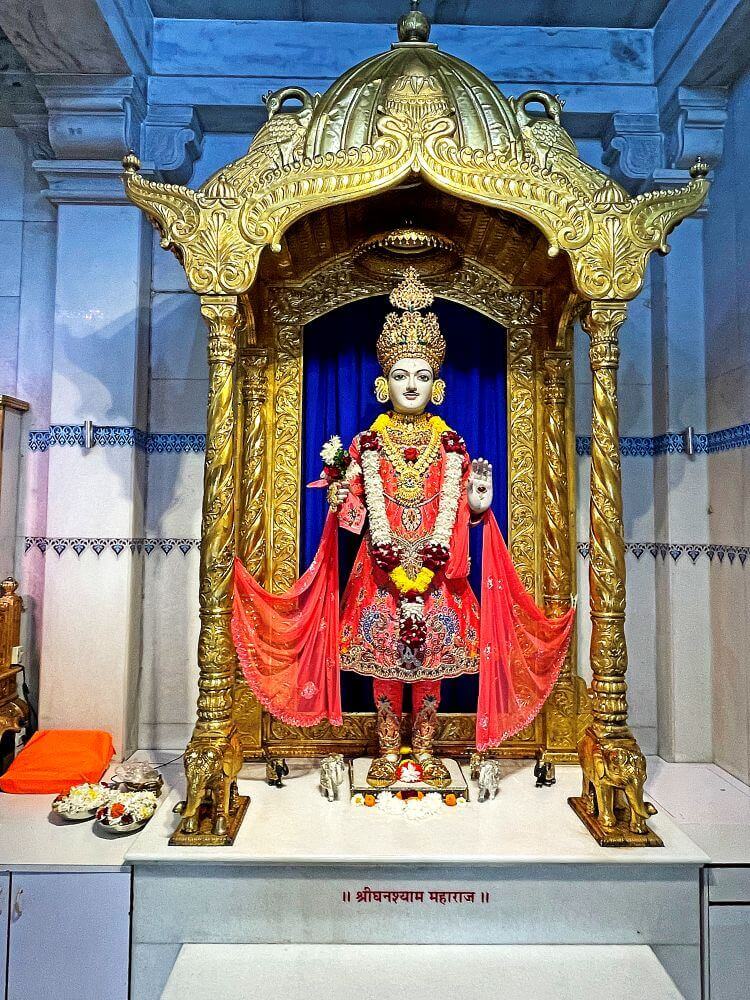 The ‘Bochasanwasi Akshar Purushottam Swaminarayan Sanstha’ (BAPS), established with the aim of fostering spiritual and social upliftment, has one of its prominent temples in Adajan, Surat. Known as the ‘BAPS Swaminarayan Temple’, this grand spiritual centre is a significant landmark in the region. Like other temples built by BAPS, this temple is renowned for its exquisite architecture and intricate carvings, making it a major attraction not only for devotees but also for tourists. Hundreds of devotees visit daily to seek the blessings of Lord Swaminarayan.
The ‘Bochasanwasi Akshar Purushottam Swaminarayan Sanstha’ (BAPS), established with the aim of fostering spiritual and social upliftment, has one of its prominent temples in Adajan, Surat. Known as the ‘BAPS Swaminarayan Temple’, this grand spiritual centre is a significant landmark in the region. Like other temples built by BAPS, this temple is renowned for its exquisite architecture and intricate carvings, making it a major attraction not only for devotees but also for tourists. Hundreds of devotees visit daily to seek the blessings of Lord Swaminarayan.
The Swaminarayan sect is a widely respected religious community in India. Its founder, Swami Sahajanand, originally hailed from Chhapaiya, a village near Ayodhya. Born in 1781, his original name was Ghanshyam Pande. At the age of 12, he renounced his home and embarked on a journey of spiritual exploration. Over the next seven years, he travelled extensively across India, spending several years in intense penance in the Himalayas. During this period, he was known as Nilkanth Varni. In 1800, he arrived in Saurashtra (present-day Gujarat). At Mangrol, he met
Swami Muktanand and later received initiation from Guru Ramanand, a leader of the Ramandi sect, at Piplana. He chose Gujarat as the base for his spiritual and social reform activities. 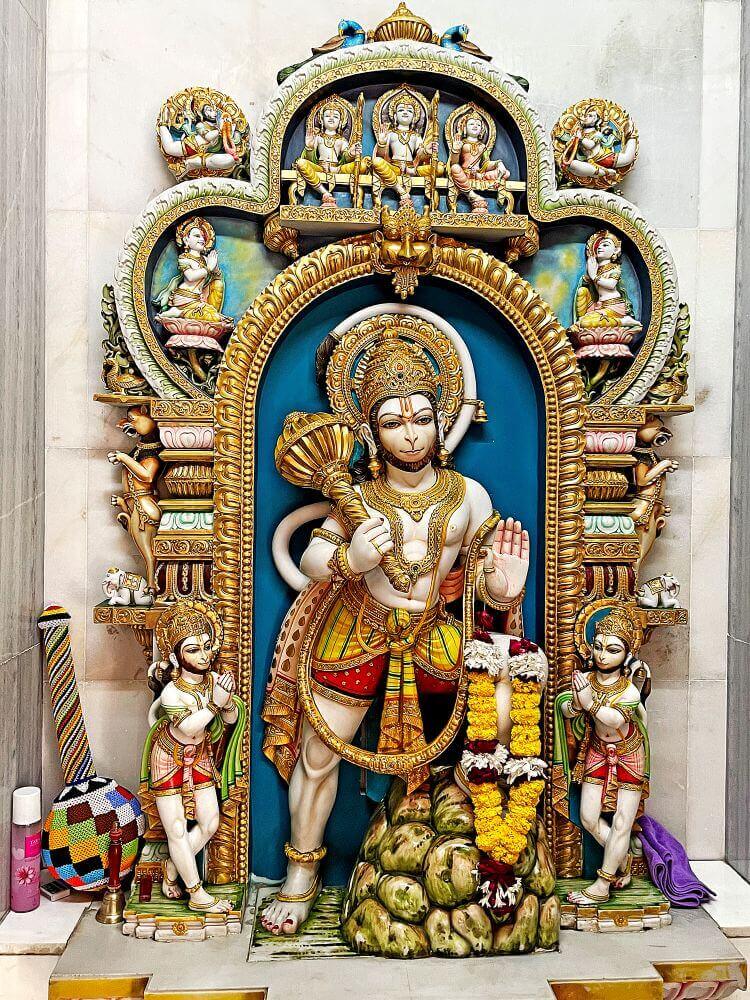 Drawing from the principles of Ramanujacharya’s Vishishtadvaita (qualified non-dualism) and Vallabhacharya’s Shuddhadvaita (pure non-dualism), he propagated a harmonised philosophy, emphasising social reform and spiritual discipline.
Drawing from the principles of Ramanujacharya’s Vishishtadvaita (qualified non-dualism) and Vallabhacharya’s Shuddhadvaita (pure non-dualism), he propagated a harmonised philosophy, emphasising social reform and spiritual discipline.
Nilkanth Varni was renamed Sahajanand by Ramanand. In 1801, after Ramanand’s passing, Sahajanand ascended to his spiritual position as the leader of the sect. He travelled extensively, imparting the Swaminarayan Mahamantra to countless devotees. Sahajanand taught that Swaminarayan was none other than Lord Krishna himself, and he encouraged worship and surrender to him. Devotees believe that Sahajanand, also known as Nilkanth Varni, was an incarnation of God. It is said that in November 1820, Sahajanand revealed to Gopalanand Swami six reasons for his incarnation on Earth. In 1830, Sahajanand, also known as Swaminarayan, passed away. After his departure, the responsibilities of the sect were carried forward by Gunatitanand Swami. Later, in 1905, Shastri Yagnapurushdas, also known as Shastri Maharaj, established the Bochasanwasi Akshar Purushottam Swaminarayan Sanstha (BAPS) within the Swaminarayan tradition. The organisation is commonly referred to by its acronym, BAPS. Shastri Maharaj believed that Lord Swaminarayan resides on Earth through the Akshar Guru (the divine guru), a tradition that began with Gunatitanand Swami. Today, Mahant Swami Maharaj is the sixth spiritual leader (Acharya) of this sect.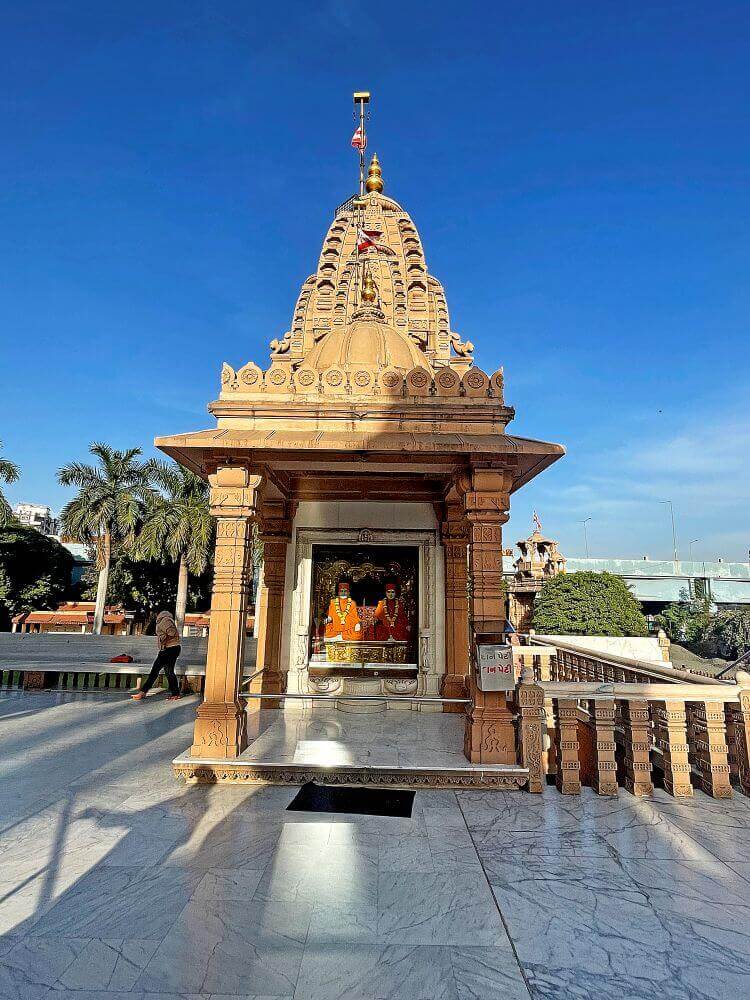
In 1907, Shastri Maharaj established the first BAPS Swaminarayan temple at Bochasan. Since then, over a thousand BAPS Swaminarayan temples have been built worldwide, including the one in Surat. The Surat temple was constructed under the guidance of Pramukh Swami, the fifth spiritual leader of BAPS. This temple holds a history spanning nearly a hundred years. While the exact date of its founding is not available, it is believed to have been constructed in the early years of the 20th century.
Located on the banks of the Tapi River, Adajan is one of the oldest settlements in the Surat region and is now an integral part of Surat city. The magnificent Swaminarayan Temple is situated in this area. Built in the Gujarati-Hindu architectural style, the temple features red and pink sandstone, domes, pyramid-shaped spires (shikhara), tall columns, intricate carvings, and exquisite sculptures—all hallmarks of Swaminarayan temple design.
The temple complex is spacious and has two grand entrance gates at the front. These gates are adorned with wide columns that feature images of gatekeepers (dwarapal) on all four sides of their capitals. The ceilings above the gates are decorated with domed canopies in the Gurjar-Rajasthani style. The temple itself is a two-storeyed structure, with the main shrine located in a large courtyard on the upper floor. 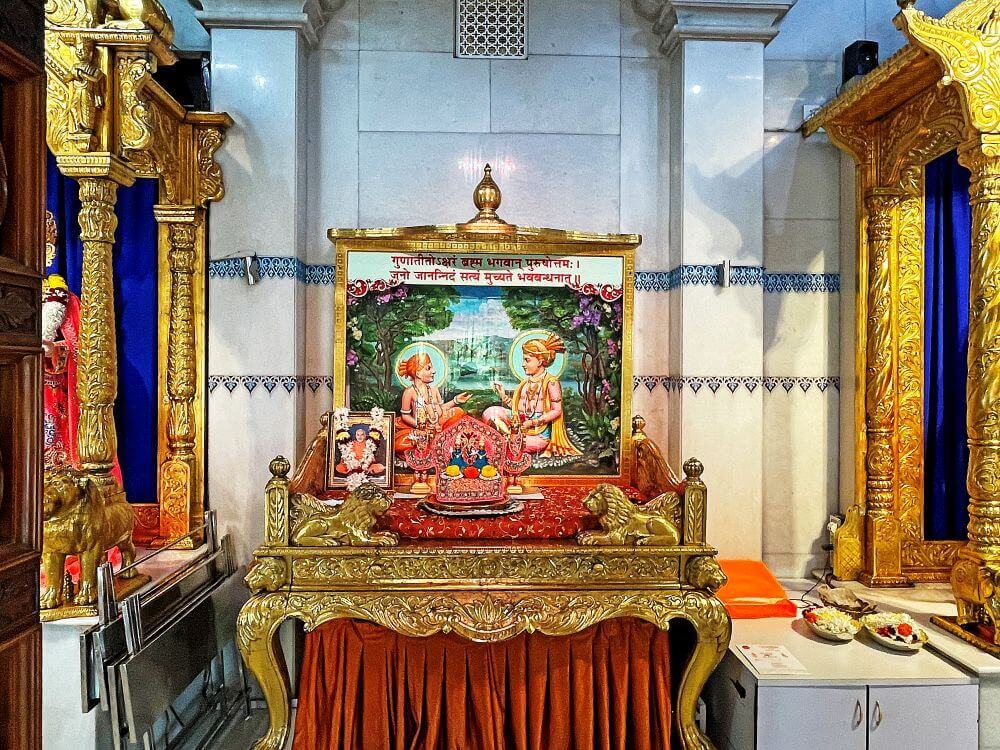 To reach this courtyard, visitors must climb 21 steps. The marble-paved courtyard provides seating arrangements for devotees. On either side of the courtyard are two smaller shrines. The left shrine houses the idols of Bhagat Maharaj and Shastri Maharaj, placed on a tall golden pedestal (vajrpeeth). Bhagat Maharaj is regarded as the second spiritual successor of Swaminarayan, while Shastri Maharaj is considered the third successor. The right shrine contains the idols of Yogi Maharaj and Pramukh Swami Maharaj. Yogi Maharaj is the fourth spiritual successor, while Pramukh Swami Maharaj is the fifth successor of Swaminarayan. At a short distance from these two shrines, in the centre of the courtyard, lies the main temple of Swaminarayan.
To reach this courtyard, visitors must climb 21 steps. The marble-paved courtyard provides seating arrangements for devotees. On either side of the courtyard are two smaller shrines. The left shrine houses the idols of Bhagat Maharaj and Shastri Maharaj, placed on a tall golden pedestal (vajrpeeth). Bhagat Maharaj is regarded as the second spiritual successor of Swaminarayan, while Shastri Maharaj is considered the third successor. The right shrine contains the idols of Yogi Maharaj and Pramukh Swami Maharaj. Yogi Maharaj is the fourth spiritual successor, while Pramukh Swami Maharaj is the fifth successor of Swaminarayan. At a short distance from these two shrines, in the centre of the courtyard, lies the main temple of Swaminarayan.
The temple is structured with a central assembly hall (sabhamandap), surrounded on three sides by porticos (mukhamandap), and the sanctum (garbhagriha) at the core. 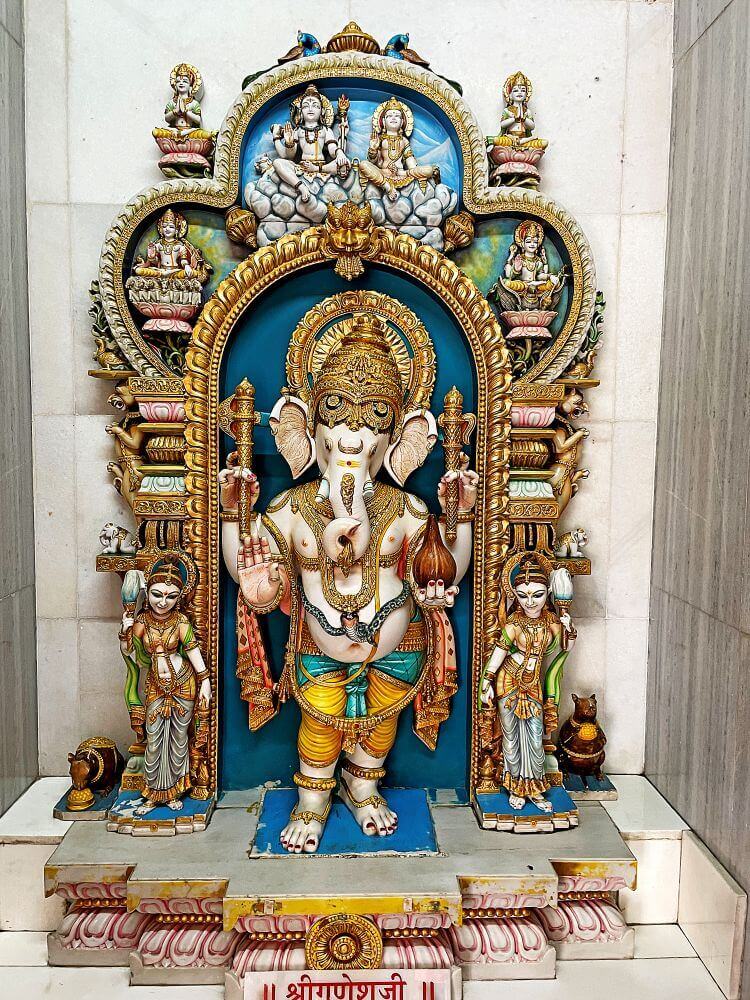 The exterior columns of the porticos are adorned with intricately carved sculptures of celestial maidens (surasundari) in various graceful poses, accompanied by decorative makar-toranas (arches with crocodile motifs). The columns within the assembly hall and the inner side of its ceiling are engraved with images of various saints, sages, and devotees associated with the Swaminarayan tradition.
The exterior columns of the porticos are adorned with intricately carved sculptures of celestial maidens (surasundari) in various graceful poses, accompanied by decorative makar-toranas (arches with crocodile motifs). The columns within the assembly hall and the inner side of its ceiling are engraved with images of various saints, sages, and devotees associated with the Swaminarayan tradition.
At the centre of the temple lies the sanctum (garbhagriha), where idols of Lord Swaminarayan, Gunatitanand Swami, and Gopaldas Swami stand in serene postures, crafted from marble and placed on a tall, intricately carved marble pedestal. These idols are housed within an ornate, gold-plated makhar (decorative framework).The side sanctums feature idols of Harikrishna Maharaj, Bansidhar Shri Krishna, Radha, Ghanshyam Maharaj, as well as Ganesha and Hanuman. All these idols are positioned on tall vajrpeeth (sacred pedestals) and encased in elaborately designed gold-plated makhars. The idols are adorned with beautiful garments and ornaments, adding to their splendour.
Even the exterior walls of the sanctum (mandovar), especially the middle sections, are decorated with sculptures of various deities and saints, making the temple a marvel of artistry and devotion. The main temple features three tall spires (shikhara) above the sanctum (garbhagriha). These spires are designed in the Nagara architectural style with the Urushringa pattern, where smaller replicas of the central spire are either constructed or carved on its “shoulders.” The two smaller temples in the courtyard also have similar tall Urushringa-style spires. The assembly hall (sabhamandap) and porticos (mukhamandap) are topped with dome-shaped spires, which are further adorned with flat amala (circular disc-like structures) at their base and crowned with sacred kalasha (pinnacles).
These spires are designed in the Nagara architectural style with the Urushringa pattern, where smaller replicas of the central spire are either constructed or carved on its “shoulders.” The two smaller temples in the courtyard also have similar tall Urushringa-style spires. The assembly hall (sabhamandap) and porticos (mukhamandap) are topped with dome-shaped spires, which are further adorned with flat amala (circular disc-like structures) at their base and crowned with sacred kalasha (pinnacles).
On the ground floor of the Swaminarayan Temple, there is a shrine dedicated to Pramukh Swami Maharaj. At the centre of a grand hall, within an intricately decorated sanctum (garbhagriha) enclosed by glass on all four sides, stands an idol of Pramukh Swami Maharaj, enshrined within a tall, golden makhar (ornate canopy).  In front of this sanctum, a beautiful, gem-studded circular altar (vedi) houses a golden idol of Nilkanth Varni. The hall also displays various items used by Pramukh Swami Maharaj and Yogiji Maharaj, preserved in glass cases. These items include utensils, bags, mirrors, turbans, rosaries (japmala), garments, pens, and other personal belongings that reflect their life and legacy. This arrangement serves as a tribute to the spiritual leaders and offers devotees a glimpse into their simple and disciplined lifestyle.
In front of this sanctum, a beautiful, gem-studded circular altar (vedi) houses a golden idol of Nilkanth Varni. The hall also displays various items used by Pramukh Swami Maharaj and Yogiji Maharaj, preserved in glass cases. These items include utensils, bags, mirrors, turbans, rosaries (japmala), garments, pens, and other personal belongings that reflect their life and legacy. This arrangement serves as a tribute to the spiritual leaders and offers devotees a glimpse into their simple and disciplined lifestyle.
Daily worship, aarti, abhishek (ritual bathing of the deity), and other religious ceremonies are performed at the Swaminarayan Temple. Festivals like Diwali, Janmashtami, Swaminarayan Jayanti, and the Annakut Mahotsav are celebrated with great enthusiasm and in a devout atmosphere. On these occasions, the temple attracts thousands of devotees. Additionally, kirtans (devotional songs), discourses, and spiritual gatherings (satsang) are organised regularly.
The temple also plays an active role in community service. Religious education is provided to children, and the BAPS organisation conducts various social and educational initiatives, such as scholarships for students, health camps, and empowerment programmes for women and youth. The temple complex includes a sales centre for BAPS products, a bookstore, a prasadalaya (dining hall serving sacred food), and a spacious, modern devotee accommodation facility.
